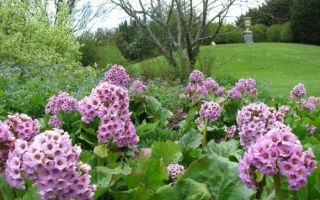Content
- 1 Description and photo of the plant
- 2 Types and varieties of badan
- 3 The chemical composition of the roots and leaves of badan
- 4 Badan nutritional value
- 5 Medicinal properties of badan
- 6 The healing properties and use of badan leaves
- 7 Medicinal properties and application of badan root
- 8 Useful properties of badan flowers
- 9 Is badan good for pregnant and lactating women
- 10 Is it possible badan for children
- 11 Traditional medicine recipes with badan
- 12 The benefits and harms of badan tea
- 13 How to make badan tea properly
- 14 Recipes for making tea from badan (chigir tea)
- 15 How to drink badan tea
- 16 The use of badan in cooking and cosmetology
- 17 Badan harm and contraindications
- 18 Berry harvesting: when to collect and how to dry
- 19 Conclusion
- 20 Reviews
The benefits and harms of badan are a question that is of great interest to gardeners and fans of traditional medicine. You can meet a medicinal plant both in the wild and in cultivated form - and its beneficial properties will be equally valuable.
Description and photo of the plant
Badan is a wild and cultivated plant, which is also called thick-leaved saxifrage. In the wild, it is found mainly in China, Mongolia and Kazakhstan, on the territory of Russia it grows in the Krasnoyarsk Territory, Yakutia and Primorye.
Recognizing the plant is quite simple. It reaches a height of about half a meter, while the rounded leaves can be up to 30 cm in length and more than 20 cm in width. Badan blooms with beautiful small flowers of white, pink or purple color, collected in inflorescences.

Types and varieties of badan
On the territory of Russia, in a cultivated form, you can mainly find two types of badan - Fat-leaved and Heart-leaved. In addition to them, there is Strech, Pacific, Schmidt, Himalayan and others.
Often, gardeners plant specially bred berry varieties with late and long flowering periods. For instance:
- Overture;
- Beethoven;
- Andrea;
- Pink Dragonfly.
The listed varieties bloom at the end of spring, and some bergenia are able to bloom a second time at the end of summer.
The chemical composition of the roots and leaves of badan
The beneficial properties of the badan herb are contained both in the leaves and in the root system of the plant. In particular, the value of Badan roots is provided by:
- glucose;
- vitamin C;
- polyphenols;
- starch;
- tannins;
- antioxidant arbutin;
- natural sugars.

The leaves of the plant also contain arbutin, which has antioxidant properties, and tannins. In addition to them, the composition includes:
- the most valuable minerals for the body are copper, iron and manganese;
- carotene and vitamin C;
- gallic acid;
- coumarins;
- resin;
- essential oils;
- flavonoids.
Badan nutritional value
The benefits and harms of saxifrage are due to the distribution of carbohydrates and proteins in it. So, in the black leaves of the plant, about 3% fructose and 13% fiber are present. Red leaves contain about 16% fiber.
The protein in the plant is represented by albumin - in the amount of about 17% - and globulins, accounting for 33%.
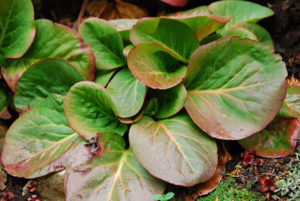
Medicinal properties of badan
Badan is a plant with great medicinal value. All parts of it have medicinal properties. Namely, they can be used as:
- antipyretic;
- immunomodulatory;
- diuretic;
- antibacterial and anti-inflammatory;
- anti-stress;
The benefits of bergenia for men are that the anticancer properties of the plant help with prostatitis.
The healing properties and use of badan leaves
The leaves of the plant are most often used to fight inflammation and infections and to stop bleeding. Decoctions and infusions from the leaves help with:
- headaches;
- rheumatism;
- pneumonia and tuberculosis;
- diarrhea and ailments of the stomach and intestines;
- sore throat;
- hypertension;
- kidney ailments.
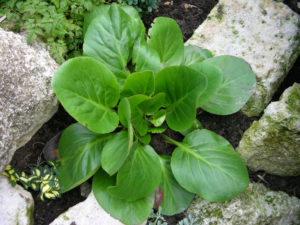
The beneficial properties of badan for women are worth noting especially - the plant removes inflammation and stops uterine bleeding, helps to cure cervical erosion.
Medicinal properties and application of badan root
The healthy root of the plant is an indispensable remedy for quick healing of wounds and cuts. Compresses and ointments based on the berry root are used to get rid of bruises and hematomas. In addition, the root is often used for:
- treating diarrhea;
- strengthening the heart and blood vessels;
- cleansing the body of toxins;
- treatment of gastric and intestinal ailments.
Useful properties of badan flowers
The flowers of the thick-leaved saxifrage are used mainly in cosmetology. They are often found in masks, scrubs, and oils for skin care.
Dry flowers are boiled, and then the hair is washed with the resulting product. Also, crushed flowers are added to mini-baths to strengthen the nail plates.
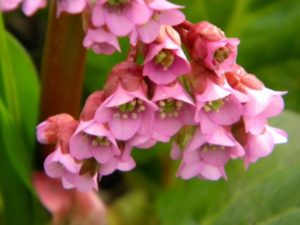
Is badan good for pregnant and lactating women
Under different conditions, the benefits and harms of bergenia for health may be different - it is better for pregnant women not to take it. The harm can be expressed in a sharp drop in blood pressure. The plant is capable of provoking constipation or diarrhea, especially if used carelessly.
It is also not recommended for nursing mothers to use a medicinal plant - the properties of bergenia can negatively affect the health of the baby.
Is it possible badan for children
Due to its medicinal properties, badan can be beneficial for young children. However, it is possible to treat a child with decoctions and infusions based on the plant only when the baby reaches 5 - 6 years old.

Traditional medicine recipes with badan
In order for the properties of badan to be beneficial, not harmful, it is necessary to know how and for what ailments the plant is used.
Decoction
Most often the rhizomes of a medicinal plant are boiled in clean water. In order to prepare a useful remedy, you will need to spend only half an hour.
- Finely chopped or ground into powder roots in the amount of 2 large spoons are poured with 0.5 liters of water, and then cooked on low heat for no more than 30 minutes under a lid.
- The finished product is filtered and cooled at room temperature.
They drink the product diluted so as not to get harm from excessive concentration, three times a day, before meals, in an amount of no more than 2 large spoons.
A root-based decoction is good for hemorrhoids and gynecological ailments, gastritis and ulcers. It will be useful for colds, inflammatory diseases, coughs.

Infusion
Chopped roots and leaves can simply be poured with boiling water (1 glass per 1 large spoonful of raw materials) and held under the lid for 2 hours. Drink a useful infusion 3-4 times a day, no more than 2 large spoons at a time.
The properties of the infusion are most beneficial for tonsillitis and bleeding gums. Infusion can be used to wipe wounds and abrasions on the skin, use the remedy in the treatment of dermatological diseases.
Alcohol tincture
For colds, joint and respiratory diseases, the healing drink from alcohol-based badan is of particular benefit.
- Finely chopped root of a plant in the amount of 40 g is poured with 100 g of vodka or alcohol.
- The glass vessel is tightly closed and placed in a dark place for 10 days.
- After this period, the tincture is filtered and drunk three times a day, adding 30 drops of the product to a glass of clean water.
Alcoholic tincture is especially useful in the treatment of acute respiratory viral infections and influenza, bronchitis and pneumonia. It is also used for rubbing painful joints and for warming compresses.
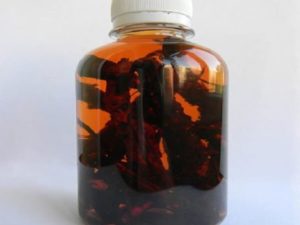
Badan extract
A couple of large tablespoons of dry crushed root or leaves are poured over 200 ml of boiling water and boiled over low heat under a lid until the water boils off by half. Then the extract is filtered and taken 30 drops three times a day for pancreatitis, inflammation and to strengthen the immune system.
Boiled incense root is beneficial for diarrhea. Also, the remedy helps against stomatitis - 20 ml of the remedy is diluted with a glass of water and rinsed out several times a day.
Badan root powder
You can grind the berry root into powder - and use it to quickly heal wounds and other skin damage. The scheme of application is very simple - wounds, ulcers and healing burns are simply sprinkled with powder, leaving it for several hours.
You can also make compresses from powder. In this case, the instruction for the berry root looks as simple as possible - it is diluted with water to a thick mass, pressed to the sore spot with gauze or a cotton pad and fixed with a bandage.

The benefits and harms of badan tea
The leaves of the plant can be used to treat diseases, but are often used simply to brew delicious and healthy teas. The benefits of badan tea are that the drink:
- saturates the body with vitamins and microelements;
- strengthens the immune system and prevents colds;
- improves bowel function;
- has a light tonic effect and relaxes well.
However, tea from the leaves of the plant can be harmful. In too large quantities, the drink provokes constipation, lowers blood pressure, and can cause tachycardia. You cannot drink it with allergies and with increased blood density, tea is not recommended for young children under 5 years old and pregnant women.
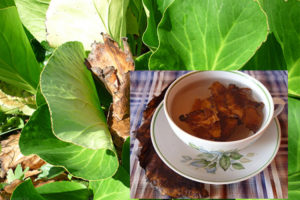
How to make badan tea properly
The algorithm for brewing healing tea is almost the same as the usual scheme.
- A large spoonful of dried leaves is poured into a teapot, previously scalded.
- Raw materials are poured into 300 - 500 ml of boiling water.
- Insist for about 20 minutes, then pour the tea leaves into a cup, dilute with water and drink.
There is only one subtlety here - in order for the tea to be infused properly, it needs to be brewed a little longer than usual.
Recipes for making tea from badan (chigir tea)
Saxifrage medicinal leaves can be brewed in different ways. Someone prefers the classic recipe, while others add other ingredients that improve the taste and beneficial properties of Chigir tea.
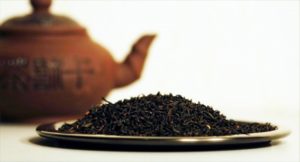
Classic recipe
The usual procedure involves using only dry berry leaves. They are poured into a teapot and poured with boiling water, then they wait 20 minutes, filter, dilute and drink.
Tea with lingonberries and incense
Lingonberry - a vitamin plant that is often used for diabetes, kidney sand, cystitis and other diseases. The leaves can be added to berry tea, enhancing its healing effect.
- 3 teaspoons of badan are poured into a small saucepan, a teaspoon of crushed lingonberry leaves and oregano are added to it.
- The raw material is poured into a glass of clean water and the tea is allowed to boil.
- The finished drink is insisted for an hour and a half under the lid, and then filtered.
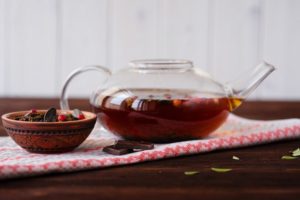
It is recommended to drink chigir tea with lingonberries twice a day for a small cup, if desired, you can add sugar or honey to it. However, with gastritis and ulcers from the drink, it is better to abstain in order to avoid harm.
Badan leaf tea with blueberries
Blueberry chigir tea is especially useful for colds and coughs.It is simple to prepare it - you need to pour water over a dry mixture of berry leaves, blueberry leaves and drupe leaves. You can also add thyme.
The mixture is boiled, then turned off and insisted closed for 2 hours. You can drink this tea up to 3 times a day.
Tea with incense and cloudberries
Cloudberry is a plant whose leaves have an antiseptic effect. Drinking chigir tea with cloudberries is useful for colds, kidney stones and cystitis; the drink also soothes well.
For its preparation, 3 teaspoons of badan are mixed with 1 teaspoon of dried cloudberry leaves, a little thyme and cuff leaves are added. The tea is boiled and kept closed for a standard time - about 20 minutes.
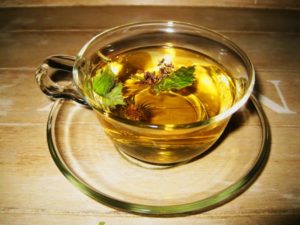
The finished drink is consumed in a cup no more than three times a day; honey or sugar, raspberries or rose hips are additionally added to it for taste and benefit.
Tea with incense and strawberries
Vitamin strawberry is of great benefit to the skin of the face, the leaves of the plant eliminate constipation and purify the blood, help with coughs. Tea is prepared as follows:
- dry strawberry leaves in the amount of 3 teaspoons are mixed with 4 tablespoons of bergenia, dried black currant foliage and chopped wheatgrass root (a teaspoon each) are added;
- the mixture is poured with water and boiled over medium heat, and then defended for about an hour.
Drink a healthy drink at will and as needed, no more than three times a day, in small cups.

How to drink badan tea
The drink brewed on dry leaves of badan can be consumed in the same way as ordinary tea - in pure form or with sugar, with honey, with sweet berries, just like that or with sweets.
The benefits and harms of tea made from badan leaves depend on the dosage of the drink. The main rule is not to abuse. A maximum of 3 cups should be drunk per day - too much bergenia provokes constipation and a decrease in blood pressure, leading to poor health.
The use of badan in cooking and cosmetology
In one form or another, badan is often found in cosmetics - masks and oils, creams, scrubs. Also, on its basis, you can independently prepare homemade mixtures for face and body care.
- Badan smoothes the skin, has a tightening effect, eliminates acne and acne.
- Products based on the leaves and flowers of this herb help to cope with dandruff and strengthen hair.
- Badan can be used to treat the skin of the hands and nails - the beneficial substances in the plant strengthen the nail plates, soften the cuticle.
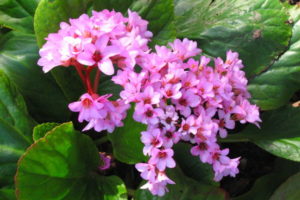
The beneficial properties of the saxifrage plant are also used in cooking. Badan roots, carefully dried, are added in small pieces or in the form of flour to side dishes and soups, taken as an ingredient for baking.
Badan harm and contraindications
Badan - both benefits and harm to the body. It all depends on the state of health. Various plant-based drinks can be harmful. In particular, badan leaves are prohibited for use:
- if you have an allergy;
- with chronically low blood pressure;
- with increased blood density and a tendency to thrombosis.
Badan roots can provoke pressure surges, therefore, it is not recommended to take decoctions with them both in case of hypotension and in case of hypertension. It is better not to use root-based products and for diseases of the heart and blood vessels, so as not to get harm.
As for tea with badan, it is not advised to use it with a tendency to constipation, since it has a fixing effect.
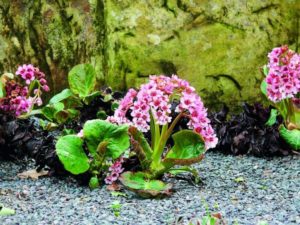
Pregnancy, lactation and age under 5 years are considered as general contraindications for the use of bergenia - the risk that the body will be harmed is too great.
Berry harvesting: when to collect and how to dry
For plant parts to be of maximum benefit, they must be harvested at specific times of the year and properly processed.
Leaves
Saxifrage foliage and flowers are harvested from late June to mid-July, and then dried in a dry place with good ventilation at a temperature not exceeding 50 degrees. Do not expose raw materials to open sunlight.The ready-made dry collection retains its beneficial properties for 4 years.
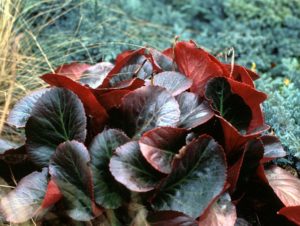
Roots
Plant rhizomes are also harvested in June or July. Immediately after digging, the roots must be cleaned of the ground and rinsed, then cut into large pieces of 10 - 15 cm and cut each lengthwise.
For 3 days, the cut rhizomes are dried in a dry place in the shade, and then dried until brittleness appears - the temperature should not exceed 45 degrees. Dry raw materials are laid out in paper bags or fabric bags and stored in the dark and dry for up to 4 years.
Conclusion
The benefits and harms of badan are determined by whether there are absolute contraindications to use. When used carefully in small dosages, the plant will strengthen the body's strength and help get rid of many ailments.

